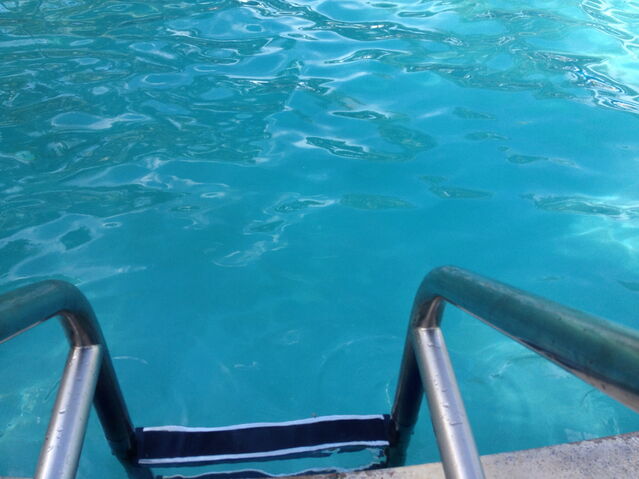Fear
How to Overcome Fear of Water
Drowning prevention begins with learning to manage anxiety outside the pool.
Posted December 9, 2014 Reviewed by Ekua Hagan

I’ve been traveling the country speaking about facing fear since Some Nerve came out last year. Nowhere has it been more of a life and death issue than the 11th annual World Aquatic Health Conference (WAHC) hosted by the non-profit National Swimming Pool Foundation®(NSPF®), where I gave a keynote speech in October. This year, the WAHC focused on how to help people overcome their fear of water, to find solutions to the perpetual high rates of drowning in this country, and to begin a conversation amongst attendees on how to move forward.
Look at these statistics:
Two-thirds of Americans are afraid of deep, open bodies of water and 46% are afraid of the deep end of a pool. Thirty-seven percent of Americans are unable to swim, and almost 4000 people a year in the United States die of drowning.
Knowing how to swim (and equally important, knowing how to prevent panic in the water) are unquestionably life-saving skills, but if most swim lessons begin with “get in the pool,” those afraid of that first step will avoid lessons entirely.
Those who enter the pool afraid are often prone to panic at some point in their learning and never go back. Studies show that most children of non-swimmers don’t get enough practice to become competent swimmers themselves, perpetuating the cycle. How can we help the millions of fearful swimmers learn to enjoy the water safely?
We must address the fear first.
Anyone who enters the pool feeling overwhelmed by fear of embarrassment, failing, or being out of control, or who goes into flight/fight mode, will have a terribly hard time listening and learning over their pounding heart and racing thoughts.
In my remarks, I advocated for training swim instructors on how fear and anxiety affect students physically and emotionally, and how to de-escalate the fear and regain control. In profiling aquatic therapists like Jeff Krieger of Strategies for Overcoming Aquatic Phobias for the Water chapter of Some Nerve, I observed several differences in his approach vs the standard beginner class:
- Starting the lesson outside the pool and establishing trust. Very often anxious students are told, “there’s nothing to be afraid of.” But they are afraid. So anyone who says this immediately loses credibility. Taking the student’s concerns seriously before they enter the water makes them feel more safe and able to learn.
- Demystifying the water, explaining the properties of buoyancy, what happens when we’re in it and it goes into our ears or nose, washes overhead, etc.
- Practicing relaxation techniques like breathing and visualization outside the water first so they become easily accessible if needed in the pool.
- Going slow and accepting that it may be an emotional process, but keeping the goal clear: competence in the deep end. While many believe the fear of water is simply too hard to overcome, that isn’t true. In the documentary film Taking the Plunge (produced by Shawnelle King of Falcon Rattler Media) screened at WAHC, we see two of Jeff’s adult students go from tears in the shallow end to swimming laps with pride and joy within 10 classes.
Even more than learning strokes, learning to cope with fear and maintaining ease in the water is what prevents drowning. I can swim but ever since I had a terrifying experience getting swept down a river as a teen, I’ve struggled with anxiety in moving water. I once needed the lifeguard to pull me up in the three feet of water at the bottom of a waterslide, simply because I was flustered and forgot how to stand up. Even competitive swimmers panic — that’s why there are swim angels to help triathletes in the open water. When you get scared, you forget what you know. Teaching people what to do when they feel fear is about the most empowering antidote.
In the U.S. today, there are only a handful of swim instructors who specialize in teaching fearful students (presenting at the WAHC were Jeff Krieger of Strategies for Overcoming Aquatic Phobias (S.O.A.P.), Melon Dash of Miracle Swim, and Kimberlee Shults of Face in Water). These pioneers have developed effective strategies that have helped many, many students but there is still so much need out there.
If you or someone you love is afraid of the water, connect with them, or advocate for your local pool to get their staff trained by them. I would love to see basic “Getting Comfortable in the Water” classes as ubiquitous as Toastmasters International which started with 1 club to help people overcome the fear of public speaking and has grown to over 13,000 chapters in 116 countries. Why not?
With the energy, imagination, and commitment of aquatics professionals like the nearly 400 swim program directors, pool operators, health officials, parks & recreation representatives who attended WAHC, everything is possible. Many were eager to brainstorm ideas at the conference — we talked about adding parent classes alongside kids classes, or offering a free private lesson for parents of kids enrolled. We talked about enlisting mental health professionals to get certified to teach or consult with staff. We talked about starting every beginner class outside the pool, with more direct instruction on managing anxiety. We talked about Spanish language classes in underserved communities. Talk that I am confident will lead to action.
Perhaps most moving for me were the swim instructors who told me that they never understood the adult students who couldn’t do basic things like put their face in the water and blow bubbles before. More than one had tears in their eyes as they said things like, “I had students quit after one lesson and I never knew why. I wish I could go back and do it over again,” and “Now, I get it. This is going to help me understand my students a whole lot better.”
What can you do to help? Can you raise awareness of the issue in your community? Can you fundraise to get pool staff trained to teach fearful swimmers? Or build partnerships between health and wellness providers to educate the public about anxiety and drowning prevention? A good place to donate is the NSPF Step Into Swim Campaign, a 10-year initiative to create 1 million new swimmers. So far they have raised $103,427 with matching funds.
Let’s start viewing fear of water as something that can be overcome, and swimming as a human right. All of us can play a part in saving and improving lives by sharing our ideas and then taking the plunge.




